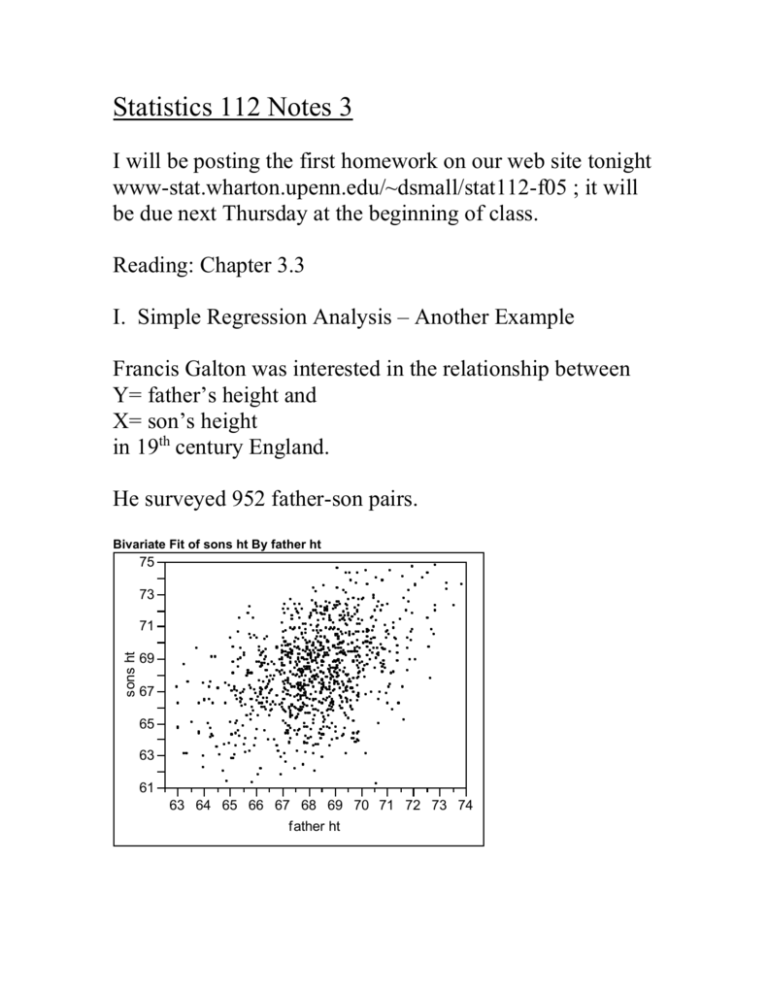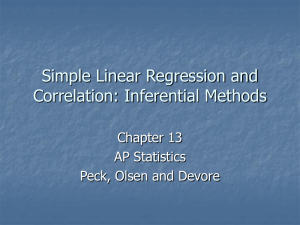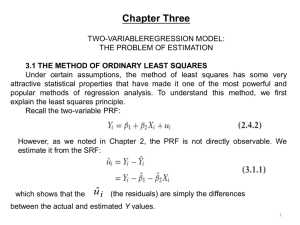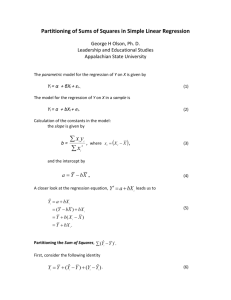Statistics 512 Notes I D
advertisement

Statistics 112 Notes 3 I will be posting the first homework on our web site tonight www-stat.wharton.upenn.edu/~dsmall/stat112-f05 ; it will be due next Thursday at the beginning of class. Reading: Chapter 3.3 I. Simple Regression Analysis – Another Example Francis Galton was interested in the relationship between Y= father’s height and X= son’s height in 19th century England. He surveyed 952 father-son pairs. Bivariate Fit of sons ht By father ht 75 73 sons ht 71 69 67 65 63 61 63 64 65 66 67 68 69 70 71 72 73 74 father ht Simple regression analysis seeks to estimate the mean of son’s height given father’s height, E(Y|x). The simple linear regression model is E (Y | x) 0 1 x To estimate 0 , 1 , we use the least squares method. Using our sample of data, we estimate 0 , 1 by b0 , b1 where b0 , b1 are chosen to minimize the sum of squared prediction errors in the data (the least squares method). Bivariate Fit of sons ht By father ht 75 73 sons ht 71 69 67 65 63 61 63 64 65 66 67 68 69 70 71 72 73 74 father ht Linear Fit Linear Fit sons ht = 26.455559 + 0.6115222 father ht Each one inch increase in father’s height is (estimated to be) associated with an increase in mean son’s height of 0.61 inches. II. Simple Linear Regression Model Assumptions The sample data (Y1 , X1 ), population. , (Yn , X n ) is a sample from a We care about learning about the mean of Y given X in the population not in the sample, e.g., The real estate agent from Lecture 2 who did the regression of X=house size on Y=selling price was interested in the relationship between these variables for all houses in Gainesville, FL not just the 93 houses in her sample. Galton is interested in how father’s height relates to son’s height in all of England, not just among these 952 father-son pairs. The least squares method provides estimates b0 , b1 of 0 , 1 based on the sample – these estimates will differ for differ samples and typically will not exactly be correct. Standard errors and confidence intervals for 0 , 1 are used to quantify our uncertainty about 0 , 1 . To compute standard errors and confidence intervals, we need to have a model for how the data arises from the population. The simple linear regression model: Yi 0 1 xi ei . The ei are called disturbances and it is assumed that 1. Linearity assumption: The conditional expected value of the disturbances given xi is zero, E (ei ) 0 , for each i. This implies that E (Y | x) 0 1 x so that the expected value of Y given X is a linear function of X. 2. Constant variance: assumption: The disturbances ei are assumed to all have the same variance 2 . 3. Normality assumption: The disturbances ei are assumed to have a normal distribution. 4. Independence assumption: The disturbances ei are assumed to be independent. This is an assumption that is most important when the data are gathered over time. When the data are cross-sectional (that is, gathered at the same point in time for different individual units), this is typically not an assumption of concern. Steps in simple regression analysis: 1. Observe pairs of data (x1,y1),…,(xn,yn) that are a sample from population of interest. 2. Plot the data. 3. Assume simple linear regression model assumptions hold. 4. Estimate the true regression line E (Y | x) 0 1 x by the least squares line Eˆ (Y | x) b b x . 0 1 5. Check whether the assumptions of the ideal model are reasonable (Chapter 6). If assumptions don’t hold, consider transforming some of the variables (Chapter 5). 6. Make inferences concerning coefficients 0 , 1 and make predictions ( ŷ b0 b1 x ).











